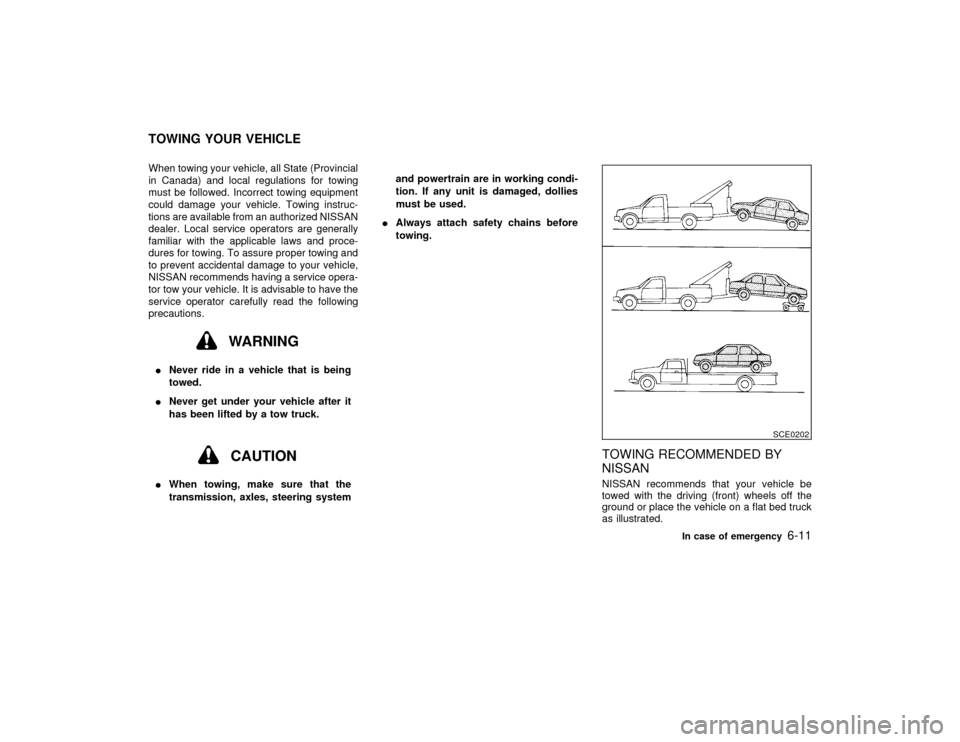towing NISSAN MAXIMA 2001 A33 / 5.G Owners Manual
[x] Cancel search | Manufacturer: NISSAN, Model Year: 2001, Model line: MAXIMA, Model: NISSAN MAXIMA 2001 A33 / 5.GPages: 247, PDF Size: 1.99 MB
Page 150 of 247

6 In case of emergencyFlat tire ...................................................................... 6-2
Changing a flat tire ............................................... 6-2
Jump starting............................................................. 6-7
Push starting ............................................................. 6-9If your vehicle overheats ......................................... 6-10
Towing your vehicle ................................................ 6-11
Towing recommended by NISSAN .................... 6-11
Vehicle recovery (Freeing a stuck vehicle) ........ 6-12
Z
00.1.17/A33-D/V5.0
X
Page 156 of 247

Stowing the damaged tire and toolsSecurely store the spare tire and jacking
equipment in the vehicle.
WARNING
IAlways make sure that the spare tire
and jacking equipment are properly
secured after use. Such items can
become dangerous projectiles in an
accident or sudden stop.
IThe T-type spare tire and small sizespare tire are designed for emer-
gency use. See ªTires and wheelsº in
the ª8. Do-it-yourselfº section.To start your engine with a booster battery, the
instructions and precautions below must be
followed.
WARNING
IIf done incorrectly, jump starting can
lead to a battery explosion, resulting
in severe injury or death. It could also
damage your vehicle.
IExplosive hydrogen gas is always
present in the vicinity of the battery.
Keep all sparks and flames away from
the battery.
IDo not allow battery fluid to come
into contact with eyes, skin, cloth or
painted surfaces. Battery fluid is a
corrosive sulphuric acid solution
which can cause severe burns. If the
fluid should come into contact with
anything, immediately flush the con-
tacted area with water.
IKeep battery out of the reach of
children.
SCE0040
JUMP STARTING
In case of emergency
6-7
Z
00.1.17/A33-D/V5.0
X
Page 160 of 247

When towing your vehicle, all State (Provincial
in Canada) and local regulations for towing
must be followed. Incorrect towing equipment
could damage your vehicle. Towing instruc-
tions are available from an authorized NISSAN
dealer. Local service operators are generally
familiar with the applicable laws and proce-
dures for towing. To assure proper towing and
to prevent accidental damage to your vehicle,
NISSAN recommends having a service opera-
tor tow your vehicle. It is advisable to have the
service operator carefully read the following
precautions.
WARNING
INever ride in a vehicle that is being
towed.
INever get under your vehicle after it
has been lifted by a tow truck.
CAUTION
IWhen towing, make sure that the
transmission, axles, steering systemand powertrain are in working condi-
tion. If any unit is damaged, dollies
must be used.
IAlways attach safety chains before
towing.
TOWING RECOMMENDED BY
NISSANNISSAN recommends that your vehicle be
towed with the driving (front) wheels off the
ground or place the vehicle on a flat bed truck
as illustrated.
SCE0202
TOWING YOUR VEHICLE
In case of emergency
6-11
Z
00.1.17/A33-D/V5.0
X
Page 161 of 247

CAUTION
INever tow automatic transmission
models with the front wheels on theground or four wheels on the ground
(forward or backward) as this may
cause serious and expensive damage
to the transmission.
If it is necessary to tow the vehicle
with the rear wheels raised, always
use towing dollies under the front
wheels.
IWhen towing automatic transmission
models with the front wheels on tow-
ing dollies, or when towing manual
transmission models with the front
wheels on the ground:
ITurn the ignition key to the OFF
position, and secure the steering
wheel in a straight ahead position
with a rope or similar device.
Never secure the steering wheel
by turning the ignition key to the
LOCK position. This may damage
the steering lock mechanism.
IMove the gearshift lever to the N
(Neutral) position.
IWhen towing automatic or manualtransmission models with the rear
wheels on the ground (if you do not
use towing dollies): Always release
the parking brake.
VEHICLE RECOVERY (Freeing a
stuck vehicle)ITow chains or cables must be attached only
to the main structural members of the ve-
hicle.
IPulling devices should be routed so they do
not touch any part of the suspension, steer-
ing, brake or cooling systems.
IAlways pull the cable straight out from the
front or rear of the vehicle. Never pull on the
vehicle at an angle.
IPulling devices such as ropes or canvas
straps are not recommended for use in
vehicle towing or recovery.
IStand clear of an stuck vehicle.
SCE0199
6-12
In case of emergency
Z
00.1.17/A33-D/V5.0
X
Page 210 of 247

you should notice any leaks or if gasoline
fumes are evident, check for the cause and
have it corrected immediately.To ensure smooth, trouble-free, safe and eco-
nomical driving, NISSAN provides two differ-
ent maintenance schedules that may be used,
depending upon the conditions in which you
usually drive. These schedules contain both
distance and time intervals, up to 60,000 miles
(96,000 km)/48 months. For most people, the
odometer reading will indicate when service is
needed. However, if you drive very little, your
vehicle should be serviced at the regular time
intervals shown in the schedule.After 60,000
miles (96,000 km) or 48 months, continue
the periodic maintenance at the same
mileage/time intervals.
SCHEDULE 1Follow Periodic Maintenance Schedule 1 if
your driving habits frequently include one or
more of the following driving conditions:
Irepeated short trips of less than 5 miles
(8 km).
Irepeated short trips of less than 10 miles
(16 km) with outside temperatures re-
maining below freezing.
Ioperating in hot weather in stop-and-go
rush hour traffic.
Iextensive idling and/or low speed driv-
ing for long distances, such as police,
taxi or door-to-door delivery use.Idriving in dusty conditions.
Idriving on rough, muddy, or salt spread
roads.
Itowing a trailer, using a camper or a
car-top carrier.
SCHEDULE 2Follow Periodic Maintenance Schedule 2 if
none of the driving conditions shown in Sched-
ule 1 apply to your driving habits.
PERIODIC MAINTENANCE
SCHEDULES
Maintenance
9-5
Z
00.1.17/A33-D/V5.0
X
Page 212 of 247

Schedule 1Abbreviations: I = Inspect. Correct or replace if necessary.MAINTENANCE OPERATIONMAINTENANCE INTERVAL
Perform at number of miles, kilometers or
months, whichever comes first.Miles x 1,000 3.8 7.5 11.3 15 18.8 22.5 26.3 30 33.8 37.5 41.3 45 48.8 52.5 56.3 60
(km x 1,000) (6) (12) (18) (24) (30) (36) (42) (48) (54) (60) (66) (72) (78) (84) (90) (96)
Months 3 6 9 12 15 18 21 24 27 30 33 36 39 42 45 48Chassis and body maintenanceBrake lines & cablesIIII
Brake pads & rotorsIIIIIIII
Manual transaxle oil or automatic
transaxle fluidSee NOTE (1).IIII
Steering gear & linkage, axle & suspension partsIIIIIIII
Tire rotation See NOTE (3).
Exhaust systemIIIIIIII
Front drive shaft bootsIIIIIIII
Supplemental air bag system and supplemental
side air bag systemsSee NOTE (2).
Automatic Speed Control Device (ASCD) vacuum hosesIIIINOTE: (1) If towing a trailer, using a camper or a car-top carrier, or driving on rough or muddy roads, change (not just inspect) oil at
every 30,000 miles (48,000 km) or 24 months.
(2) Inspect the supplemental air bag systems 10 years after the date of manufacture noted on the F.M.V.S.S. certification label.
(3) Refer to ªTire rotationº under the ªGeneral maintenanceº heading earlier in this section.
Maintenance
9-7
Z
00.1.17/A33-D/V5.0
X
Page 216 of 247

10 Technical and consumer informationCapacities and recommended fuel/lubricants ......... 10-2
Fuel recommendation ......................................... 10-3
Engine oil and oil filter recommendation ............ 10-5
Recommended SAE viscosity number ............... 10-6
Air conditioning system refrigerant and lubricant
recommendations ............................................... 10-6
Specifications .......................................................... 10-7
Engine ................................................................ 10-7
Tires and wheels ................................................ 10-9
Dimensions and weights .................................... 10-9
When traveling or registering your vehicle in
another country ..................................................... 10-10
Vehicle identification ............................................. 10-10
Vehicle identification number (VIN) plate ......... 10-10
Vehicle identification number
(Chassis number) ............................................. 10-10
Engine serial number ....................................... 10-11
F.M.V.S.S. certification label ............................ 10-11
Emission control information label ................... 10-11Tire placard ...................................................... 10-12
Air conditioner specification label ..................... 10-12
Installing front license plate................................... 10-13
Vehicle loading information ................................... 10-14
Terms ............................................................... 10-14
Determining vehicle load capacity.................... 10-14
Loading tips ...................................................... 10-15
Towing a trailer ..................................................... 10-15
Maximum load limits ......................................... 10-16
Towing safety ................................................... 10-17
Uniform tire quality grading ................................... 10-19
Emission control system warranty ........................ 10-20
Reporting safety defects (US only) ....................... 10-20
Readiness for inspection/maintenance (I/M) test
(US only) ............................................................... 10-21
Owner's Manual/Service Manual order
information............................................................. 10-22
In the event of a collision ...................................... 10-22
Z
00.1.17/A33-D/V5.0
X
Page 221 of 247

for the reason described in change intervals.Change intervalsThe oil and oil filter change intervals for your
engine are based on the use of the specified
quality oils and filters. Oil and filter other than
the specified quality, or oil and filter change
intervals longer than recommended could re-
duce engine life. Damage to engines caused
by improper maintenance or use of incorrect
oil and filter quality and/or viscosity is not
covered by the new NISSAN vehicle warran-
ties.
Your engine was filled with a high quality
engine oil when it was built. You do not have to
change the oil before the first recommended
change interval. Oil and filter change intervals
depend upon how you use your vehicle. Op-
eration under the following conditions may
require more frequent oil and filter changes.
Irepeated short distance driving at cold out-
side temperatures,
Idriving in dusty conditions,
Iextensive idling,
Itowing a trailer.
RECOMMENDED SAE VISCOSITY
NUMBERSAE 5W-30 viscosity oil is preferred for all
ambient temperatures. SAE 10W-30,
10W-40 viscosity oil may be used if the
ambient temperature is above 0ÉF (þ18ÉC).
AIR CONDITIONING SYSTEM
REFRIGERANT AND LUBRICANT
RECOMMENDATIONSThe air conditioning system in this NISSAN
vehicle must be charged with the refriger-
ant HFC-134a (R-134a) and the lubricant,
Nissan A/C System Oil Type S or the exact
equivalents.
CAUTION
The use of any other refrigerant or lubri-
cant will cause severe damage to the air
conditioning system and will require the
replacement of all air conditioner sys-
tem components.
The refrigerant HFC-134a (R-134a) in your
NISSAN vehicle will not harm the earth's
ozone layer. Although this refrigerant does not
affect the earth's atmosphere, certain govern-
mental regulations require the recovery and
recycling of any refrigerant during automotive
air conditioning system service. Your NISSAN
dealer has the trained technicians and equip-
ment needed to recover and recycle your air
conditioning system refrigerant.
TI1028-C
10-6
Technical and consumer information
Z
00.1.17/A33-D/V5.0
X
Page 230 of 247

ceeded. If GVWR is exceeded, remove
cargo as necessary. If either the front or
rear GAWR is exceeded, shift the load or
remove cargo as necessary.
LOADING TIPSIThe GVW must not exceed GVWR or
GAWR as specified on the F.M.V.S.S. cer-
tification label.
IDo not load the front and rear axle to the
GAWR. Doing so will exceed the GVWR.
WARNING
IProperly secure all cargo to help pre-
vent it from sliding or shifting. Do not
place cargo higher than the seat-
backs. In a sudden stop or collision,
unsecured cargo could cause per-
sonal injury.
IDo not load your vehicle any heavier
than the GVWR or the maximum front
and rear GAWRs. If you do, parts on
your vehicle can break, or it can
change the way your vehicle handles.
This could result in loss of controland cause personal injury.
IOverloading can shorten the life of
your vehicle. Failures caused by
overloading are not covered by your
warranty.
Your new vehicle was designed to be used
primarily to carry passengers and cargo. Re-
member that towing a trailer will place addi-
tional loads on your vehicle's engine, drive
train, steering, braking and other systems.
Information on trailer towing ability and the
special equipment required should be ob-
tained from your Nissan dealer. He can obtain
aNissan Trailer Towing Guidefor you.
TI1011M
TOWING A TRAILERTechnical and consumer information
10-15
Z
00.1.17/A33-D/V5.0
X
Page 231 of 247

MAXIMUM LOAD LIMITS
Maximum trailer loadsNever allow the total trailer load to exceed
1,000 lb (454 kg). The total trailer load equals
trailer weight plus its cargo weight. Towing
loads greater than 1,000 lb (454 kg) or using
improper towing equipment could adversely
affect vehicle handling, braking and perfor-
mance.
The ability of your vehicle to tow a trailer is not
only related to the maximum trailer loads, but
also the places you plan to tow. Tow weights
appropriate for level highway driving may have
to be reduced on very steep grades or in low
traction situations (for example, on slippery
boat ramps).
WARNING
Vehicle damage and/or personal injury
resulting from improper towing proce-
dures are not covered by NISSAN war-
ranties. A Nissan Trailer Towing Guide
(U.S. only) containing information on
trailer towing ability and the specialequipment required may be obtained
from an authorized NISSAN dealer.
Tongue loadKeep the tongue load between 9 and 11% of
the total trailer load. If the tongue load be-
comes excessive, rearrange cargo to allow for
proper tongue load.
Maximum gross vehicle weight/
maximum gross axle weightThe gross vehicle weight of the towing vehicle
must not exceed. GVWR shown on the
F.M.V.S.S. certification label. The gross ve-
hicle weight equals the combined weight of the
unloaded vehicle, passengers, luggage, hitch,
trailer tongue load and any other optional
equipment. In addition, front or rear gross axle
weight must not exceed GAWR shown on the
F.M.V.S.S. certification label.
TI1012M
10-16
Technical and consumer information
Z
00.1.17/A33-D/V5.0
X